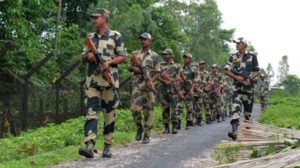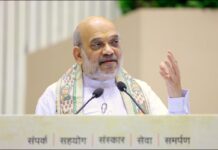
NEW DELHI: Pontoon bridges, sluice gates and airships will be deployed to plug the riverine and vulnerable frontier patches along the 60-km stretch on the Indo-Bangla border in Assam with government hoping to completely seal it by June next year.
With the help of high-resolution cameras, a stricter vigil will be kept on the porous border that is perennially used for infiltration and smuggling of cattle and drugs, officials privy to the development said.
The Border Security Force has constituted a team of senior officials to accomplish the target by involving officials from the Assam government and those from premier technology institutions like IITs.
As per a blueprint prepared in this regard, a total of 60.7-km long Indo-Bangla International Border (IB) in Assam is to be plugged by deploying smart technology and non-physical barriers.
Hence, in riverine areas pontoon bridges are proposed to be laid so that BSF personnel can patrol and make ‘morchas’ (observation posts) atop them to monitor any movement along the border where rivers and rivulets run.
Of the 284-km Indo-Bangla border that falls in Assam, about 224-km is fenced. India shares a 4,096-km frontier with Bangladesh on the eastern flank.
Also, it is proposed to build over two dozen sluice gates on the rivers, including in Dhubri area, so that the flow of water can be controlled and regulated and the phenomenon of Brahmaputra River ‘changing its course’ during monsoons checked.
Officials said the border guarding force can also create some permanent watch towers in the area marked by dense jungles.
“Ever year when Brahmaputra changes course the BSF posts get hit and some get demolished. Many have to be abandoned. Sluice gates can provide a solution to this challenge,” they said.
It is also proposed, the blueprint said, to deploy static aerial platforms like aerostats that can be loaded with intelligent high-resolution cameras to ‘watch over’ the border area.
“A smart operational command and control room will be created that will have all the machine and human surveillance feeds coming to it. The control room will be connected with optic fiber so that it can collect data from the ground and relay it up to Guwahati and further to the BSF headquarters in Delhi,” they said.
BSF Director General K K Sharma and Additional DG A P Maheshwari had recently travelled to the affected areas in Assam and also briefed newly appointed Assam Chief Minister Sarbananda Sonowal about the survey and analysis they conducted in the IB areas. .
Officials said the force is also looking at placing ‘unattended ground sensors’ in forward areas of the IB so that any movement can be picked up in the dense forest areas.
“An assortment of high resolution cameras, radars, infra red sensors and hand-held thermal imagers is being planned to be deployed to ensure that the border is sealed and that any breach is quickly reported. A special team is working on this,” they said.
However, the maximum work of infrastructure creation is to be done by state government and civic agencies, they said.
The BSF has also submitted a preliminary assessment report in this regard to the Home Ministry and a delegation of senior officials is set to travel again to Assam next month, they said.
They said out of the total 60.7-kms of the unfenced Indo-Bangla border in Assam, at 100 locations covering 11.9-km an ‘all weather’ fence is proposed to be created while at the other 48.8-km border area, non-physical barriers like these smart solutions will be deployed.
In the run up to the Assembly elections in the state, BJP had promised to seal the Indo-Bangladesh border in the state completely to check illegal immigration from the neighboring country.
Home Minister Rajnath Singh had also held a high-level meeting in Delhi last week and had asked agencies to ensure that the job of sealing the Indo-Bangla border in Assam is completed by June, 2017. -PTI






